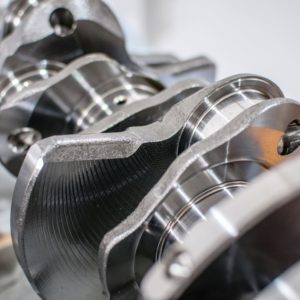The crankshaft position sensor is an integral part of your engine. It identifies the position and speed of your engine’s crankshaft. Your vehicle’s powertrain control module (PCM) uses this data when determining the spark timing and (in most cases) fuel injector synchronization.
If the PCM receives a variation that exceeds a calibrated percentage, a P0315 code will be set.
What Does the P0315 Code Mean?
Diagnostic trouble code (DTC) P0315 stands for “Crankshaft Position System Variation Not Learned.”
The crankshaft position sensor measures the crankshaft’s speed and position using a toothed wheel located on your vehicle’s crankshaft or harmonic balancer. The PCM uses this data to calculate spark timing, fuel injector synchronization, and other functions, such as variable valve timing system operation.

The data gathered by the sensor is compared to learned reference point values that take into account slight tolerance variations between the crankshaft position sensor and crankshaft. If the values are not stored in the PCM’s memory, code P0315 will be set.
The P0315 code is usually related to an electrical or computer fault. In some cases, it may also be triggered by mechanical issues, depending on the vehicle.
Our technical discussion about how the PCM establishes a baseline snapshot of crankshaft position sensor pulses can help you understand codes like P0315 more fully.
Note: The definition of code P0315 code may be different per vehicle manufacturer. Consult the appropriate repair manual or repair database for the exact code definition.
What are the Possible Causes of the P0315 Code?
- Crankshaft position relearn procedure not performed/improperly performed
- Faulty crankshaft position sensor
- Circuit issues between the crankshaft position sensor and PCM
- An internal problem with the PCM
- Damaged crankshaft or reluctor wheel

What are the Common Symptoms of the P0315 Code?
- Activated check engine light
- Engine may crank but it won’t start
- Misfires, bucking, or surging
How to Diagnose the P0315 Code
A DTC P0315 refers to a generic trouble code that can be logged in vehicles from different automakers. While the symptoms and triggers for this trouble code may be similar across some makes and models, the diagnosis and repair steps may vary depending on the specific vehicle that you own.
If you’re not an experienced automotive DIYer, we recommend taking your vehicle to an auto repair shop for proper diagnosis and repair. If you’re determined to solve the issue yourself, you may review this video for additional information about this trouble code:
How to Fix the P0315 Code
Fixing a P0315 code can be tricky, especially if you don’t have the tools and experience to get the job done. In most cases, it’s best to leave the job to a trusted professional. However, if you’re an experienced DIYer, you can deal with the code yourself. Consult repair manuals or get a subscription to a repair database for vehicle-specific repair steps.
Fast Delivery of Crankshaft Position Sensor
Why leave the comfort of your home to get a new crankshaft position sensor? Order a replacement part online from CarParts.com. Not only is it easy, you won’t have to wait long before the crankshaft position sensor reaches your doorstep.
CarParts.com operates multiple distribution centers across the US. When you purchase a crankshaft position sensor from our online store, our nearest warehouse processes your order and ships the part. You can expect the crankshaft position sensor within several business days if you live in the continental US and order by noon ET. Our secure online shopping process is effortless, allowing you to place an order with only several taps on your phone’s screen. If you have any questions about our crankshaft position sensors, our helpful customer service team is ready with the answers you need.
Get great discounts on high-grade replacement crankshaft position sensors at CarParts.com. Browse our wide selection of crankshaft position sensors today!
Any information provided on this Website is for informational purposes only and is not intended to replace consultation with a professional mechanic. The accuracy and timeliness of the information may change from the time of publication.


















